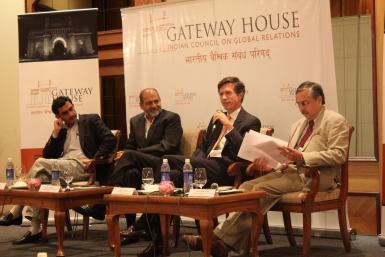
Gateway House: Indian Council on Global Relations, Mumbai, hosted a meeting today on The Indian Diaspora: Converging Destinies. The role of the Indian Diaspora was on the discussion agenda at the India-US Strategic Dialogue held in Delhi from July 19 to 21.
The panelists at the Gateway House meeting were Alwyn Didar Singh (Secretary, Ministry of Overseas Indian Affairs), Robert O. Blake (United States Assistant Secretary of State for South and Central Asian Affairs), Devesh Kapur (Director, Centre for the Advanced Study of India, University of Pennsylvania) and Adil Zainulbhai (Managing Director, India, McKinsey & Company). They discussed the phenomenon of the growing return migration of the Indian Diaspora to India – at nearly 100,000 a year, the largest ever recorded in India’s history.
Professor Kapur – the foremost expert on the India Diaspora –provided the background of migration and creation of a diaspora. He said that the determinants of outward emigration were economic conditions and policies of the country of departure rather than the attractiveness and policies of the country of immigration. Migration from India was unrepresentative of migration anywhere in the world. The Indian Diaspora in the US is largely professional and became entrepreneurial over the years. Firms owned by Indians in the US, he said, were more productive and were likely to be more influential in the coming years.
Adil Zainulbhai, a Non Resident Indian (NRI) returnee himself, said he was part of the diaspora going out in the 1970s and 1980s, and is part of the diaspora now coming back. He talked of the adjustments that NRIs made, about the “little irritations” that returnees experienced which often sent them back to their host countries. However, what counterbalanced it was “the sheer joy and excitement of being present at the creation of this country” much like being in Silicon Valley in the 1990s. “That overwhelms all minor irritants,” said Zainulbhai. Corruption, however, was a “major problem” and crisis – but that crises stimulated corrective measures. “You never want to waste a crisis,” he said.
Assistant Secretary Robert O. Blake, fresh from the negotiations of the India-U.S. Strategic Dialogue in Delhi, came to Mumbai for the diaspora meeting. He said everyone wanted to be part of this “exciting process of change” during this stage of India’s growth and that Indian think tanks, like Gateway House, have an important intellectual contribution to make on these issues.
On the Indian diaspora, he said Indian Americans were eager to contribute to India but didn’t know how or who to engage with, where it was corrupt and what were safe to invest in. The U.S government was creating a mechanism that will help the diaspora with their philanthropy efforts in India. A key initiative was to appoint Indian Americans like Mitul Desai to the post of Advisor on the Diaspora, within the U.S. State Department.
Alwyn Didar Singh, the Secretary of the Ministry of Overseas Indian Affairs, said India today was seeing one of the highest returning migrant flows in the world. Over 60,000 professionals and an estimated 40,000 labour were returning to India every year. Emigration comprised professionals, migrant labourers, and students which amounted to almost a million. India received $54 billion in 2010 –the highest remittances of any country in the world. Years ago, NRIs felt out of place in India –“Not Required Indians,” as he said. These days, however, they are called “Now Returning Indians. It is a major circular migration, and a convergence of destinies,” said Singh.
